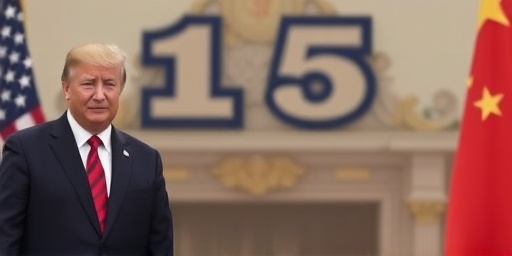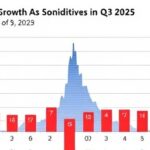In a surprise diplomatic breakthrough, President Donald Trump and Chinese President Xi Jinping have agreed to lower proposed tariffs on Chinese imports from an initial 57% to 47%, easing some tensions in the ongoing U.S.-China trade war. The announcement came after a high-stakes meeting at Mar-a-Lago, where the two leaders discussed strategies to balance fair trade practices with economic stability. While this reduction offers a glimmer of hope for U.S. manufacturers facing skyrocketing input costs, economists warn that the impact on inflation could be unpredictable, potentially staving off price hikes in consumer goods but complicating the Federal Reserve’s monetary policy.
- Details Emerge from Mar-a-Lago Summit on Tariff Negotiations
- U.S. Manufacturing Sector Breathes Sigh of Relief Amid Tariff Cuts
- Inflation Pressures in Spotlight as Economists Debate Tariff Effects
- Broader Implications for Global Supply Chains and Policy Shifts
- Looking Ahead: Uncertainties in U.S.-China Trade and Economic Recovery
Details Emerge from Mar-a-Lago Summit on Tariff Negotiations
The presidential meeting, which lasted over six hours, focused intensely on the contentious issue of tariffs that have defined U.S.-China trade relations since 2018. Sources close to the negotiations revealed that Trump pushed for immediate concessions to protect American jobs in key manufacturing sectors, while Xi emphasized the need for mutual benefits to avoid a global economic slowdown. The original 57% tariff proposal, aimed at electronics, machinery, and apparel imports from China, was a escalation from earlier rounds and had sparked fears of retaliatory measures from Beijing.
According to a White House statement, the compromise to 47% was reached after Trump highlighted data showing that full implementation could add $300 billion to annual U.S. import costs. “This is a win for American workers,” Trump declared in a post-meeting tweet, underscoring his administration’s commitment to revitalizing domestic manufacturing. On the Chinese side, state media reported Xi’s satisfaction with the de-escalation, noting it as a step toward “win-win cooperation.”
Trade experts, such as those from the Peterson Institute for International Economics, have long argued that such tariffs distort global supply chains. In a recent report, the institute estimated that the pre-reduction 57% rate could have reduced U.S. GDP growth by 0.5 percentage points in the coming year. The lowered 47% threshold, while still significant, might mitigate some of that damage, potentially saving U.S. businesses up to $50 billion in avoided duties.
U.S. Manufacturing Sector Breathes Sigh of Relief Amid Tariff Cuts
The manufacturing industry, a cornerstone of Trump’s economic agenda, stands to gain the most from this tariff adjustment. Companies reliant on Chinese components, from automotive giants like Ford and General Motors to tech firms such as Apple, have been vocal about the burdens of escalating duties. The National Association of Manufacturers (NAM) issued a statement praising the move, stating, “Reducing tariffs to 47% provides much-needed predictability for supply chains and could prevent thousands of job losses in U.S. factories.”
Statistics from the U.S. Census Bureau illustrate the stakes: In 2022, imports from China accounted for 18% of total U.S. goods imports, valued at over $500 billion, with manufacturing inputs making up 40% of that figure. High tariffs have already led to a 15% drop in bilateral trade volume since the trade war’s onset, forcing manufacturers to seek alternatives in countries like Vietnam and Mexico. However, reshoring efforts remain slow; a survey by Deloitte found that only 25% of U.S. firms have fully relocated supply chains away from China due to cost and infrastructure challenges.
Industry leaders echoed these sentiments. Mary Barra, CEO of General Motors, told CNBC, “This tariff relief allows us to stabilize prices for American consumers and invest more in domestic production.” Similarly, the American Apparel & Footwear Association reported that apparel tariffs alone could have increased retail prices by 10-15%, a burden now partially alleviated. Yet, challenges persist: Even at 47%, tariffs on critical materials like steel and semiconductors could raise production costs by 8-12%, according to the U.S. Chamber of Commerce.
Inflation Pressures in Spotlight as Economists Debate Tariff Effects
While the tariff reduction is a boon for manufacturing, its ripple effects on inflation have analysts divided. The Consumer Price Index (CPI) has hovered around 3.5% year-over-year, with imported goods contributing significantly to upward pressure. Federal Reserve Chair Jerome Powell recently noted in testimony before Congress that trade policies like tariffs act as a “tax on consumers,” potentially fueling inflationary spirals if not managed carefully.
Proponents of the cuts argue they will temper inflation by keeping import prices in check. A Moody’s Analytics forecast suggests that the 10% tariff drop could shave 0.2-0.3 percentage points off CPI growth over the next 12 months, particularly in categories like electronics (down 5%) and household appliances (down 7%). This aligns with Trump’s narrative that targeted tariffs protect U.S.-China trade without derailing economic recovery post-pandemic.
Conversely, skeptics warn of unintended consequences. Harvard economist Dani Rodrik pointed out in a Bloomberg op-ed, “Lowering tariffs might encourage more imports, flooding the market and pressuring domestic manufacturers, which could indirectly stoke wage inflation.” Data from the Bureau of Labor Statistics supports this duality: Manufacturing employment rose by 200,000 jobs in the past year, but wage growth in the sector hit 4.5%, outpacing overall inflation. If tariffs at 47% still incentivize offshoring, the result could be higher unemployment-driven inflation in rust-belt states.
Global markets reacted positively, with the Dow Jones Industrial Average climbing 1.2% on the announcement day, reflecting investor optimism about stabilized U.S.-China trade dynamics. However, commodity prices, including oil and metals, showed volatility, as reduced tariffs might ease demand for U.S.-sourced alternatives.
Broader Implications for Global Supply Chains and Policy Shifts
Beyond immediate economic impacts, the Trump-Xi agreement signals a potential pivot in U.S. trade policy. The deal includes provisions for joint working groups to address intellectual property theft and subsidies in China’s manufacturing sector—long-standing grievances for Washington. This could lead to further tariff adjustments if compliance benchmarks are met, offering a roadmap out of the trade impasse.
Internationally, the move has implications for allies and competitors alike. The European Union, which imposed its own tariffs on Chinese goods, may follow suit to avoid competitive disadvantages. Meanwhile, emerging markets in Southeast Asia could see a surge in investment as U.S. firms diversify away from China, albeit slowly. The World Trade Organization (WTO) welcomed the de-escalation, with Director-General Ngozi Okonjo-Iweala stating, “This step toward dialogue is crucial for multilateral trade stability.”
Domestically, the agreement bolsters Trump’s reelection pitch on economic nationalism. Polls from Gallup indicate that 55% of voters prioritize manufacturing jobs, and this tariff relief could sway Midwestern battlegrounds. Critics, including Democratic lawmakers, argue it’s insufficient, calling for comprehensive legislation to decouple from China entirely. Senate Minority Leader Chuck Schumer remarked, “Tariffs at 47% are still a drag on innovation; we need bold investments in American tech.”
As implementation begins in the coming months, stakeholders will monitor enforcement closely. The U.S. Trade Representative’s office plans quarterly reviews, with potential for additional cuts if China boosts purchases of U.S. agricultural and energy exports—key demands from Trump’s team.
Looking Ahead: Uncertainties in U.S.-China Trade and Economic Recovery
With tariffs now at 47%, the path forward for U.S.-China trade remains fraught with uncertainties. Economists project moderate growth in manufacturing output, potentially adding 100,000-150,000 jobs by 2024, but inflation could fluctuate between 2.5% and 4% depending on global events like energy prices or supply disruptions. The Federal Reserve might hold interest rates steady longer if tariff-induced price stability materializes, aiding consumer spending.
Trump’s administration has hinted at expanding the deal to include services trade, where the U.S. holds a surplus, potentially unlocking $100 billion in new opportunities. However, geopolitical tensions, including issues in the South China Sea and Taiwan, could unravel progress. Business leaders urge sustained diplomacy: “The real test is implementation,” said Jamie Dimon, CEO of JPMorgan Chase, in a recent earnings call.
For everyday Americans, the tariff cuts mean steadier prices at the checkout for everything from smartphones to clothing, but vigilance is needed to ensure manufacturing gains translate to widespread prosperity. As the U.S. navigates this new chapter in U.S.-China trade, the balance between protectionism and openness will define the economic landscape for years to come.









